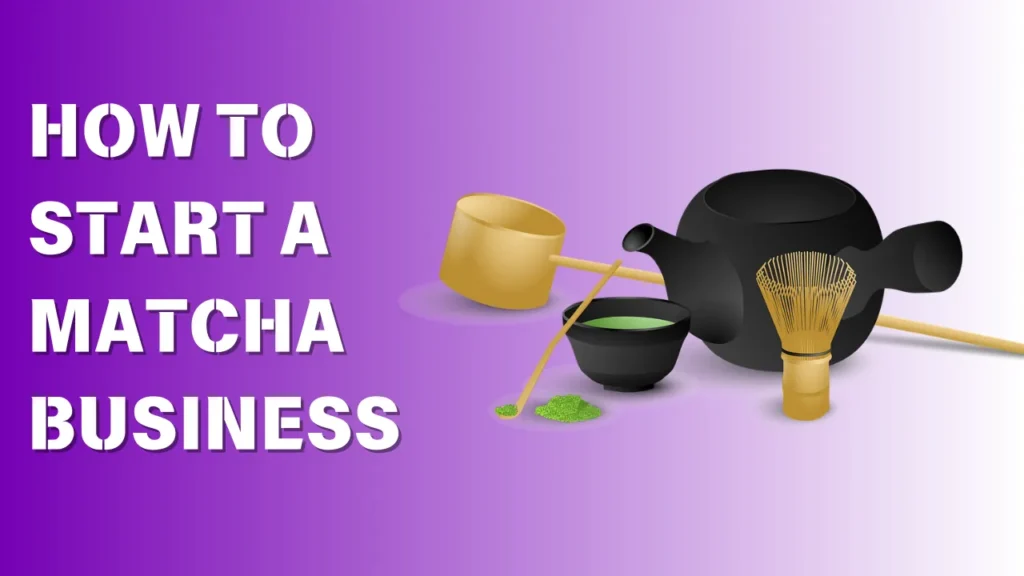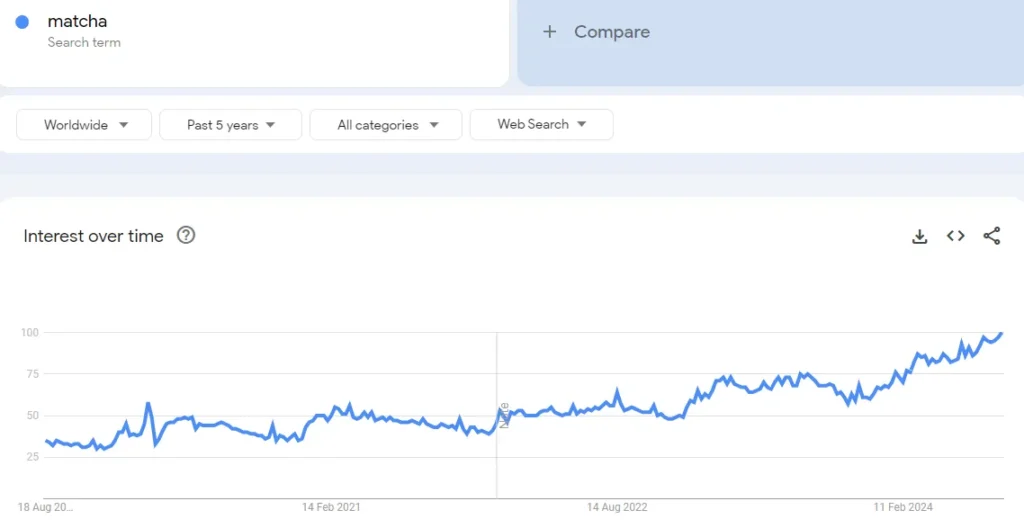Matcha is becoming popular, with growing health benefits, taste, and well-being, green tea consumption is on the rise in the wake of the COVID-19 pandemic.
As a result of this epidemic, the market is facing a new transformation, consumer purchasing habits have suddenly changed from physical cafes or stores to buying online from home.
While COVID-19 accelerated this trend, still the market continues to drive growth in the online sector. However after the situation changed, physical cafes also gained popularity again.
Recent data: The Matcha market is growing.
According to (Future Market Insights) a research report on the matcha market – the market size was valued at US$ 2.7 Billion in 2023. With a 10.2% Compound annual growth rate (2023-2033), the market is expected to reach US$ 7.1 Billion by 2033.

So many ideas are available in the green tea or matcha market so you might be confused.
Some entrepreneurs focus on matcha production, which requires proper skills in (growing, harvesting, processing, and producing matcha powder).
Suitable option – you can open a matcha cafe, a retail or e-commerce store, wholesale, or even set up a product-based line.
Here’s an overview of how to start a matcha business, if you are curious, then Let’s get started.
What is matcha?
Matcha tea is a popular and healthy beverage that has gained widespread popularity in many countries. It’s a high-quality powdered green tea made from specially grown tea leaves.
Matcha is a Japanese green tea, that provides an amazing taste, also gaining popularity worldwide. It is made with the finest tea leaves (known as Tencha) and has great flavor and nutritional value.
The best part of this matcha tea is that it comes with higher nutrients and antioxidants, which are super beneficial for our health and body and a mind refresher.
Health benefits include reducing stress, improving our mental clarity, and boosting our metabolism. Many people take green tea to enhance their healthy lifestyle naturally.
If you want to learn more about matcha health benefits, then read the content.
Matcha business ideas and concept
Before getting started do research and learn as much as possible about matcha.
Learn deeper into matcha green tea: understand its properties, health benefits, and the powder-making process. Next, create a business plan to start your matcha empire.
The ideal business model for your matcha business depends largely on your interests, skills, and target market. Here are some possible examples to consider:
- Matcha retail
- Matcha wholesale
- Matcha cafe
Knowing the difference between those business models is essential to building your business and targeting the right customers -read the brief explanation of those models.
Matcha retail
Retail business means – you selling your products directly to consumers, the terms use business-to-consumer (B2C).
To start the business as a matcha retailer – find reliable suppliers (producers, wholesalers, importers, distributors), for buying high-quality matcha powder in bulk.
Example to understand the matcha retail:
Wholesale price: You might purchase a kilogram of ceremonial-grade matcha from a wholesaler for $200, this is the cost of goods sold (COGS).
Retail price: Covering operational costs (store rent, staff, marketing, packaging, etc.), adding a profit margin, you might sell a 30-gram tin/pack of matcha for $30.
If we calculate the profit:
- One kilogram: 1000 grams
- Cost per gram: $200/1000 grams: $0.20/gram
- Cost of 30 grams matcha: $0.20/gram *30 grams = $6
- Profit per tin: $30 (selling price) – $6 (cost) = $24
So the profit margin is much higher. But important to consider the operational expenses also.
Matcha is often sold in smaller quantities (pouches, tin cans, glass jars, small containers).
While selling matcha, you can also sell tea accessories (bamboo whisks, tea bowls, scoops), and complementary products (matcha-infused snacks, ceramics).
You can sell matcha retail by opening a specialty tea shop, health food store, dedicated matcha shop, or even sell online through e-commerce platforms (Amazon or Etsy).
Your target audience could be – health enthusiasts, tea enthusiasts, wellness enthusiasts, and all individuals who want to buy matcha or green tea products.
What do you need to start? Product knowledge, contacts with suppliers, physical sales location (must be in a high foot traffic area), facility (for storage), branding (name, logo, packaging, label), sales channel setup (for online – e-commerce store design), marketing, and operations.
Wholesale
Wholesale is another business model – where you can sell goods to businesses (retailers, cafes, stores), buying bulk in larger quality from manufacturers, producers, or importers.
As a matcha wholesaler:
- Buy high-quality matcha in bulk from (producers, importers, or distributors).
- Repackaging into smaller quantities for retail.
- Selling them to retailers, cafes, and other businesses.
Wholesalers can also provide value-added services:
- Private label options – create custom matcha products for other companies to sell those products under their own brand name.
- Specialized blends: Develop unique matcha blends with different flavors (lavender, chocolate, vanilla, lemon, lime, etc), focusing on market trends and demand.
The core business model is: buying at a lower cost per unit due to bulk purchasing and selling at a higher price per unit after repackaging. B2B model – Business-to-business.
Matcha wholesale suppliers:
Includes importers, domestic producers, and blenders.
To find suppliers – visit Alibaba, ThomasNet, or search for industry-specific directories. Search online – use specific keywords like “matcha wholesale supplier,” “matcha bulk supplier,” or “Japanese matcha supplier.”
Matcha wholesale clients:
Businesses buying matcha in bulk – retailers (grocery stores, health food stores, specialty tea shops), food service (cafes, restaurants, bakeries), online stores, distributors, and matcha-based product manufacturers.
Steps to follow:
- Identify potential suppliers and wholesale clients.
- Build strong relationships with both suppliers and clients.
- Develop sales strategies and distribution channels.
- Create competitive pricing and negotiate contracts.
Matcha Cafe
Another idea is a traditional matcha cafe, where you can serve your customers a relaxed dining experience or quick and convenient fast-casual service.
Steps: choose a suitable spot with high foot traffic, design your cafe with the necessary amenities, develop a menu, follow local zoning laws, and create a marketing plan.
Opening the cafe, you can attract customers such as health-conscious individuals, young professionals, foodies, students, vegans, and fitness enthusiasts.
Find an ideal spot for opening your cafe:
Research properly on demographics targeting a potential location.
Select the ideal location considering the target customers, competition, high foot traffic, legalities, and cost of renting or buying a physical space.
Ideal spots to attract more customers: open your cafe near busy urban areas, college campuses, shopping malls, gyms, tourist spots, office buildings, and residential areas.
Prepare a menu:
After finding a suitable space, develop a menu for your matcha cafe.
Define your cafe’s concept, whether it is traditional, modern, or health-focused.
Understand your target audience preferences and develop a menu presenting classic and innovative matcha-based drinks and food. Learn from your competitors or research the market.
Sourcing supplies and ingredients:
Whenever you buy anything – be it ingredients (matcha powder) or matcha-making supplies, check the quality and authenticity of the product.
Find a reliable and trustworthy supplier, for the best buying experience.
For ingredients- tips to find the best supplier:
- Look for matcha that is certified organic
- Choose matcha that is made from shade-grown tea leaves
- Buy matcha from importers, distributors, online, or tea stores.
- If you buy online must check the supplier’s reputation (taste before buying)
You can follow some simple steps:
- Read online reviews about suppliers
- Can check the comparison guides
- If online, then check the customer comments, ratting, or reviews
- Ask someone for recommendations
- Visit your local specialty tea stores
Key steps to starting a matcha business

1. Research on the target market
Market research is the foremost step for understanding the customer base, product demand, trends, and market competition. Identifying your target audience requires knowing their interests.
Also, explore the area demand for green tea/matcha, and according to all you have to create your tea product by targeting their preference.
By doing market research, you can gain practical experience.
Check out relevant matcha shops/cafes, spend time with existing business owners, and talk to them about their challenges and their success stories.
You can also learn a lot from a failed business by exploring their story.
You can gain useful insights by using online educational resources (online courses, YouTube tutorials, workshops), reading books, and creating projects with experts.
Analyze trends using Google Trends to see how interest in matcha has grown over time and identify whether this is a growing trend or if it is stabilizing.

2. Develop a matcha business plan
Having a business plan helps to provide a road map, to build your business strategically.
A business plan is important because it helps you set clear goals, raise funds, and show investors that you have a solid plan, which helps to attract investors for funding.
When you write your plan, include the following steps:
- Executive summary: Write a brief overview of your business (mission statement, vision), objectives (long-term or short-term), and all key steps that you will include in this plan.
- Describe your business: Decide which legal structure (sole proprietorship, LLC) is suitable to set up your business. Also include business model/concept, market needs, etc.
- Market research: Include industrial research, trends, growth, target audience, and demographics, and conduct a competitive or SWOT analysis to analyze the strengths and weaknesses of your competitors.
- Marketing strategy: Detail how you’ll market and sell your product, including pricing (competitive/product value), packaging, branding (name, logo), and distribution.
- Operations plan: Explain your location, production process, and supplier relationships.
- Financial Plan: Write on estimated startup costs, revenue projections, and funding needs.
If you have not created your business plan yet, then follow the steps to outline your strategies. Use online templates to make the process easier, also learn from watching free tutorials from experts.

Find templates and guides online:
Check out the blog posts of these websites for detailed guides and templates: Bplans, Entrepreneur, or Small Business Administration (SBA).
3. Calculate the startup budget
Starting a business requires initial capital, whether it is your matcha or other startup idea. So for starting your matcha business, outline your budget to cover all necessary expenses.
While the matcha business doesn’t require a massive investment, having adequate funds for the right resources and initial setup is essential.
Begin by calculating all setup costs – sourcing matcha supplies, inventory, legal fees, marketing, etc.
Note:
Startup costs depend on the business concept, size, and location.
Depending on the business model the requirements can vary, as well as the startup costs.
#Matcha Retail
- High-quality matcha
- Website or physical store (rent, utilities, design)
- Logo, packaging, marketing materials
- Initial stock of products
- Packaging, labels, and shipping costs (if online)
#Matcha Wholesale
- High-quality matcha powder
- Certifications (if applicable)
- Wholesale packaging
- Marketing to attract potential clients (cafes, restaurants)
- Storage, transportation
#Matcha Cafe
- Location: Rent, leasehold improvements
- Equipment: Tea preparation, serving, kitchen
- Inventory: Matcha powder, milk, sweeteners, food items
- Staffing: Baristas, kitchen staff, management
- Branding: Store design, menu, marketing materials
- Permits and licenses: Health, business, liquor (if applicable)
Once you have calculated your budget, find different funding options such as personal savings, loans from friends and family, small business loans, and crowdfunding.
4. Consider legal requirements

While we can guide on general information related to legal considerations, however, the specific legal needs depend on location and business type.
So it is advisable to consult with a legal professional for location-based advice.
General business requirements:
- Choose an entity (sole proprietorship, partnership, LLC).
- Register your business.
- Obtain an EIN from the IRS.
- Register for state and local taxes (sales tax, income tax).
- Obtain licenses and permits from your city, county, and state.
Specific (for food & beverage):
If you are handling, preparing, or selling food or beverages (like a matcha cafe), you will need a food establishment permit from your local health department.
Matcha is a food product, so it must comply with FDA regulations. Follow the labeling requirements, food safety standards, and good manufacturing practices (GMPs).
All matcha products must have accurate labeling information (such as – ingredients in use, net weight, pricing, packaging date, expiry date, and nutrition facts.
Before applying for those licenses and permits, research, analyze, and consult a legal advisor.
Hope the ideas are helpful.
5. Develop a brand identity
In the competitive market to stand out, need to have a strong brand identity. Understand how to uniquely represent your products and create a unique image within the target audience.
Requires careful research, planning, and observation of your target market.
- Know your mission, target audience, and branding.
- Choose a unique business name and design a logo with selected colors and fonts.
- Use tin, aluminum, glass, or kraft paper to create attractive packaging, don’t forget to label, and add brand information, quality visuals, and QR code (linked website, social media, etc).
- Create a website, active on social media, and share related content with them.
Choose a business name – keep the name easy to remember, should be unique, easily spelled, product-related, or web-friendly, make sure to register a domain for the website.
Use an online business name generator for ideas.
Hopefully, those steps will help you to decide on the perfect matcha business name that will stand out from the crowd and have a lasting impact on potential consumers.
Not only your business name, and a logo can represent the identity, focus on offering high-quality matcha with competitive pricing.
Having a strategic goal to promote your matcha is a key step.
6. Create a marketing plan

Establishing your presence in the health-conscious community, and spreading awareness through different marketing channels is the key step to gaining exposure.
Your marketing strategy should focus on both local and international markets, as the product itself.
Educate your audience about the unique benefits of Matcha – publish blog posts, create YouTube tutorials, share on social media, and even create reels on Instagram to influence your followers.
Develop a well-thought marketing approach with the right messaging to connect matcha enthusiasts and build a consumer base. Promote your brand with all available marketing methods.
- Build online presence (website, social media)
- Social media marketing (Instagram, Facebook, TikTok)
- Content marketing (blogging, recipes, tutorials)
- Search engine optimization (SEO)
- Create video content on YouTube
- Create a Google Business Profile
- Email marketing and customer relation
- Partnerships and collaboration
These are just fundamentals of marketing, however, you need to analyze and learn things.
Wrapping up
Starting a business is not easy, especially if you are a beginner or just starting. We have covered the basic steps, which you should consider for your business matcha.
Building a business requires passion, dedication, and a keen eye for consumer tastes. Focus on the market demands of customers and create a high-quality product that meets their needs.
Hopefully, the blog post is a useful source for you to find the information you need to start the business, if you have any further doubts about it, comment me below.
Related blog posts:
Frequently Asked Questions
Is selling matcha profitable?
With the growing popularity of matcha, selling the product can be profitable. Before you decide to start selling -understand the market competition, sales methods, and marketing tactics. Requires careful planning, research, and effort. The profitability depends on how you sell – your pricing strategy, overhead costs, and target market.
Is matcha in demand?
Yes, matcha is in demand due to its numerous health benefits and unique taste, and it is a popular beverage worldwide.
How much does it cost to make matcha?
The cost of making matcha depends on the quality of the tea leaves, ingredients, and the production method.
What is the price of 1 kg matcha tea?
The price of 1 kg matcha tea can depend on the quality, brand, and retailer. Still, the price range is an average of $60 to $200 for a 1 kg bag of matcha tea.
Is matcha powder healthy?
Yes, Matcha is healthy. It’s rich in antioxidants and L-theanine offers potential benefits like improved focus and relaxation.





